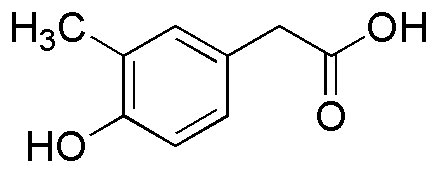4-Hydroxy-3-methylphenylacetic acid is widely utilized in research focused on:
- Pharmaceutical Development: This compound serves as an important intermediate in the synthesis of various pharmaceuticals, particularly those targeting pain relief and inflammation. Its unique structure can enhance the efficacy of drug formulations.
- Cosmetic Industry: Due to its antioxidant properties, it is incorporated into skincare products to protect against oxidative stress and improve skin health, making it a valuable ingredient in anti-aging creams.
- Agricultural Applications: It is used in the formulation of plant growth regulators, promoting healthier plant growth and improving crop yields, which is essential for sustainable agriculture.
- Food Industry: As a food additive, it can act as a preservative or flavor enhancer, contributing to the safety and quality of food products while meeting consumer demands for natural ingredients.
- Research and Analytical Chemistry: This compound is employed in various analytical techniques, including chromatography, to study complex mixtures and develop new analytical methods, aiding researchers in obtaining precise results.
General Information
Properties
Safety and Regulations
Applications
4-Hydroxy-3-methylphenylacetic acid is widely utilized in research focused on:
- Pharmaceutical Development: This compound serves as an important intermediate in the synthesis of various pharmaceuticals, particularly those targeting pain relief and inflammation. Its unique structure can enhance the efficacy of drug formulations.
- Cosmetic Industry: Due to its antioxidant properties, it is incorporated into skincare products to protect against oxidative stress and improve skin health, making it a valuable ingredient in anti-aging creams.
- Agricultural Applications: It is used in the formulation of plant growth regulators, promoting healthier plant growth and improving crop yields, which is essential for sustainable agriculture.
- Food Industry: As a food additive, it can act as a preservative or flavor enhancer, contributing to the safety and quality of food products while meeting consumer demands for natural ingredients.
- Research and Analytical Chemistry: This compound is employed in various analytical techniques, including chromatography, to study complex mixtures and develop new analytical methods, aiding researchers in obtaining precise results.
Documents
Safety Data Sheets (SDS)
The SDS provides comprehensive safety information on handling, storage, and disposal of the product.
Product Specification (PS)
The PS provides a comprehensive breakdown of the product’s properties, including chemical composition, physical state, purity, and storage requirements. It also details acceptable quality ranges and the product's intended applications.
Certificates of Analysis (COA)
Search for Certificates of Analysis (COA) by entering the products Lot Number. Lot and Batch Numbers can be found on a product’s label following the words ‘Lot’ or ‘Batch’.
*Catalog Number
*Lot Number
Certificates Of Origin (COO)
This COO confirms the country where the product was manufactured, and also details the materials and components used in it and whether it is derived from natural, synthetic, or other specific sources. This certificate may be required for customs, trade, and regulatory compliance.
*Catalog Number
*Lot Number
Safety Data Sheets (SDS)
The SDS provides comprehensive safety information on handling, storage, and disposal of the product.
DownloadProduct Specification (PS)
The PS provides a comprehensive breakdown of the product’s properties, including chemical composition, physical state, purity, and storage requirements. It also details acceptable quality ranges and the product's intended applications.
DownloadCertificates of Analysis (COA)
Search for Certificates of Analysis (COA) by entering the products Lot Number. Lot and Batch Numbers can be found on a product’s label following the words ‘Lot’ or ‘Batch’.
*Catalog Number
*Lot Number
Certificates Of Origin (COO)
This COO confirms the country where the product was manufactured, and also details the materials and components used in it and whether it is derived from natural, synthetic, or other specific sources. This certificate may be required for customs, trade, and regulatory compliance.

